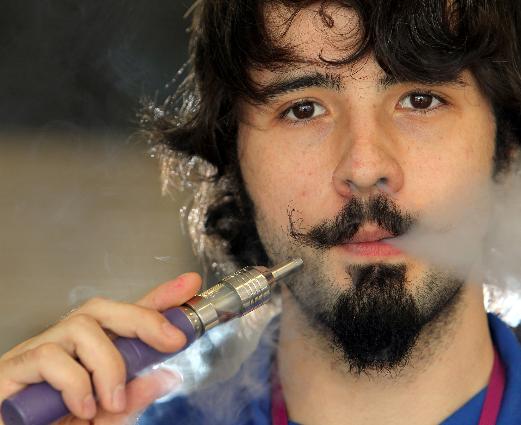E-cigarettes sprouting promise and questions
With a preoccupied gaze into the distance, Matt Tlougan inhales from the mouthpiece of a device held in his hand. A battery in its base powers a heating unit that vaporizes a concoction of confectioners’ flavors and nicotine, “juice,” as it’s known.
A few moments later, a gray-white cloud rolls out of his nostrils and mouth.
Is he smoking?
The answer, so far, is as nebulous as the cloud around him. Electronic cigarettes, or e-cigarettes, began appearing in the U.S. as something more than a curiosity around 2005. The market for them is growing at such a rate that Tlougan has opened three Vape It Zone stores since he first tried an e-cigarette himself seven months ago. At his sites in Rochester and St. Cloud, Minn., he said, sales average 20 to 25 units a day. He has similar hopes for the kiosk in The Empire Mall that opened about a month ago, and he is considering opening a fourth Vape It Zone in Brandon.
Articles from Time and the New York Timesthis year note e-cigarette sales have doubled annually since 2008 and are expected to reach $1.7 billion this year.
E-cigarette proponents say the product simulates smoking, and Tlougan said within a day of using one he was able to stop a pack-and-a-half-a-day habit of the real thing. He also gave up chewing a can of smokeless tobacco a day.
Because e-cigarettes don’t incinerate tobacco, they don’t produce the toxic chemicals associated with smoking.
However, “we don’t know what the potential health effects are from vapor, nicotine and other compounds. It kind of goes back to the early days of cigarettes,” said Dr. Daniel Heinemann of Canton, president of the South Dakota State Medical Association.
Vapor could be as bad as smoke.
“Any time you heat chemicals, they change their properties … you get chemical reactions that take place. We don’t know if other chemicals are formed in that process. That could be a problem. It could cause health effects,” Heinemann said. At the very least, e-cigarettes are a potent device for delivering addictive nicotine to the body, he said.
Doctors and public officials are looking to the Food and Drug Administration for guidance on regulating e-cigarettes.
“All of us are waiting to see what happens at the federal level,” Mary Michaels said. She is a healthy community specialist with the Sioux Falls Health Department. Depending on how the FDA approaches e-cigarettes, they might fall under the South Dakota ban on smoking in public places.
Attorneys general press for FDA study
Marty Jackley already has joined 40 other state attorneys general in urging the FDA to move quickly to study and regulate e-cigarettes.
“The nicotine found in e-cigarettes is highly addictive, has immediate biochemical effects on the brain and body at any dosage and is toxic in high doses,” the attorneys general wrote FDA Commissioner Margaret Hamburg on Oct. 23.
“Consumers are led to believe that e-cigarettes are a safe alternative to cigarettes, despite the fact that they are addictive, and there is no regulatory oversight ensuring the safety of the ingredients in e-cigarettes.”
The latter assertion is a fair point. The e-cigarettes Tlougan sells already are manufactured. However, family members, including his mother, a chemist at the Mayo Clinic, make the juice he sells.
“We make each bottle, one by one.” Quality control can be readily achieved, though “you’ve got to be on your toes,” he said. The flavorings come from candy manufacturers, and the nicotine is from an FDA-approved lab. He offers juice with nicotine concentrations ranging from 18 percent to zero, and if you have to take his word for that, well, he points out competitors are selling juice they readily acknowledge was made in China.
FDA scrutiny ultimately could help his business, Tlougan said. He would like to be able to prove he’s selling a product using certified ingredients that is as safe as the nicotine inhalers Mayo Clinic physicians give to patients who are trying to quit smoking. The only substantive difference between those and e-cigarettes, Tlougan said, is that e-cigarettes transport nicotine in vapor and inhalers don’t.
Tlougan won’t sell to minors, and he has no problem with e-cigarettes being included in smoking bans.
“It would not hurt our business if they are banned in bars and public areas. If you ask me, I think it’s a great thing. Nonsmokers shouldn’t have to be around smokers,” he said.
Sioux Falls Mayor Mike Huether is a big supporter of the smoking ban. So far, though, he isn’t making e-cigarettes a priority for inclusion under the ban. They’re flying under his radar.
“I know nothing about those,” Huether said. “I couldn’t even pick one out.”
If his position mirrors many officials’ who have yet to learn about e-cigarettes, it is not universal. Rochester moved pre-emptively as a municipality to ban e-cigarettes everywhere smoking is banned. The City Council a week ago gave final approval to an ordinance, according to Stevan Kvenvold, city administrator.
“It wasn’t subject to much debate,” Kvenvold said. “The council pretty much agreed that e-cigarettes were smoking. There was not too much back and forth about it.”
While the attorneys general want the FDA to extend to e-cigarettes the existing rules prohibiting marketing tobacco to minors, Jackley said state and local governments should decide other issues associated with them, such as taxing them and determining whether they fall under the umbrella of smoking bans.
Heinemann of the state medical association said e-cigarettes should not be sold to minors. However, his group has not yet taken a position on whether they should fall under the smoking ban.
New thing for some, quitting for others
Tlougan said his customers fall into two camps: Those who are eager to try a new experience and those who hope to use e-cigarettes to wean themselves off smoking, and he cites his own spectacular success in being able to quit a savage tobacco habit using e-cigarettes.
But Heinemann said e-cigarettes are not an ideal tool to quit smoking.
If a patient came to him asking about using an e-cigarette to quit smoking, “I would tell them there are other things we can use over time to taper you off nicotine,” such as nicotine gum and patches. He said e-cigarettes re-enforce the ritual and oral fixation that is a part of smoking. For someone trying to give up smoking, “in my mind, replacing one oral device with another, I’m not sure that gets them headed in the right direction.”
For Tlougan, though, the fact he can hold it and it has a mouthpiece hardly are coincidental. They are attractive aspects of his e-cigarette.
While he still needs nicotine, he said almost half his customers buy juice without it. “They just want the flavor.” It begs the question: How dangerous is it to inhale vaporized cinnamon, blueberry or chocolate flavoring?
“We need to study them,” Heinemann said. “For anybody to say they’re not harmful, we don’t know that yet.
“In terms of what it means to the body to inhale this, we don’t know. We need more research.
“Until we have that, the minimum should be to keep these out of the hands of children.”
http://www.argusleader.com/article/DF/20131125/NEWS/311250014/E-cigarettes-sprouting-promise-questions?nclick_check=1


